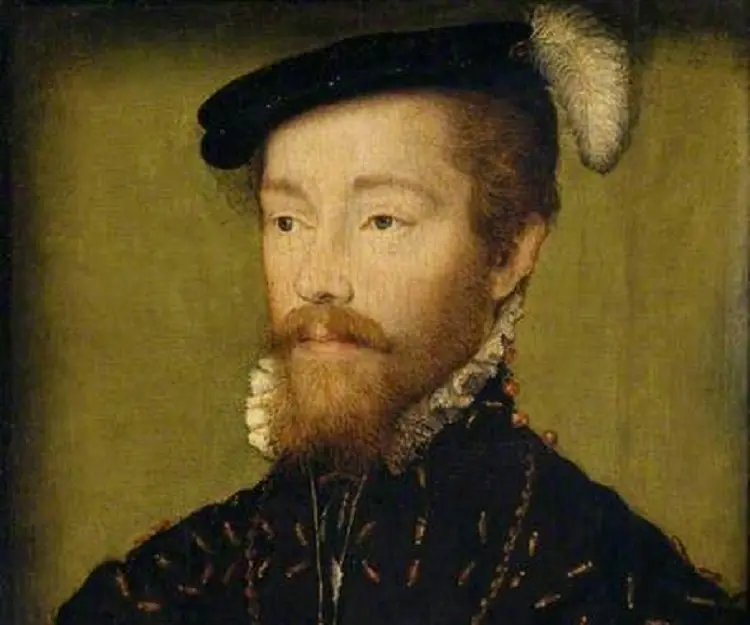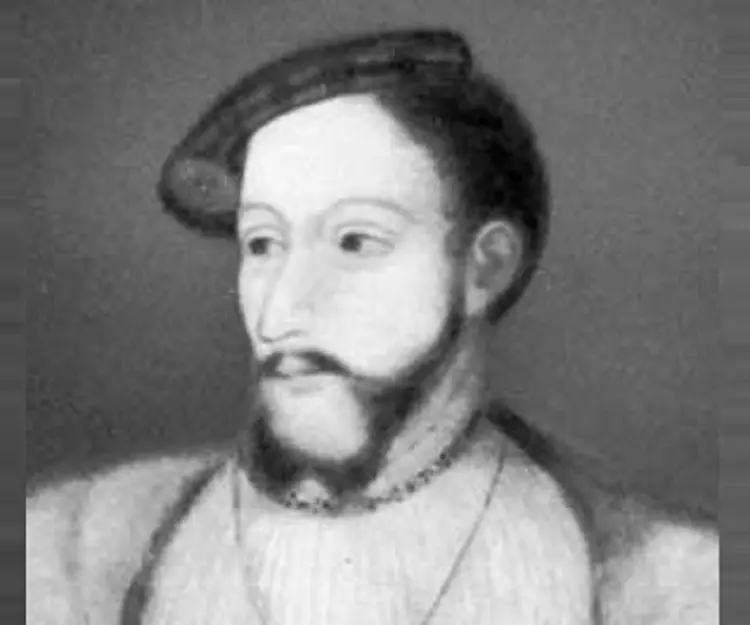
James V of Scotland - Emperors, Facts and Childhood
James V of Scotland's Personal Details
James V of the House of Stewart was a King of Scotland in the 16th Century
| Information | Detail |
|---|---|
| Birthday | April 10, 1512 |
| Died on | December 14, 1542 |
| Nationality | Scottish |
| Famous | Historical Personalities, Emperors & Kings, Emperors, Former King of Scotland, Kings, Scottish Men |
| Spouses | Madeleine of Valois (m. 1537), Mary of Guise (m. 1538) |
| Siblings | Alexander Stewart, Arthur Stewart; Duke of Rothesay, Catherine Stewart, Duke of Ross, James Stewart; 1st Earl of Moray, James; Duke of Rothesay, Lady Janet Stewart, Margaret Douglas, Margaret Stewart |
| Childrens | James Stewart |
| Birth Place | Linlithgow Palace, Linlithgow, United Kingdom |
| Gender | Male |
| Sun Sign | Aries |
| Born in | Linlithgow Palace, Linlithgow, United Kingdom |
| Famous as | Former King of Scotland |
| Died at Age | 30 |
// Famous Kings
Sundiata Keita
Sundiata Keita was the founder of the Mali Empire in West Africa. This biography profiles his childhood, early life, struggles, founding of empire, rule, administration, achievements and also gives some fun facts.
Ashoka
Ashoka was the third emperor of the Mauryan Dynasty and ruled almost the entire Indian subcontinent. This biography profiles his childhood, life, reign, achievements and timeline
Murad IV
Murad IV was one of the mighty Sultans in the history of the Ottoman Empire. This biography profiles his childhood, family, accession, rule, administration and timeline.
James V of Scotland's photo
Who is James V of Scotland?
James V of the House of Stewart was a King of Scotland in the 16th Century. Following the death of his father King James IV of Scotland at the Battle of Flodden Field, he ascended to the Scottish throne when he was only seventeen months old. Several regents—including his mother, John Stewart, 2nd Duke of Albany, and Robert Maxwell, 5th Lord Maxwell—successively ruled in his name during the early years of his reign. At the age of 12, he dismissed the regents and was declared the king. However, it was decided that he would still be under the guardianship of a selected group of high nobility and spend three months with each, rotating among them. In 1528, he assumed the control of the government himself. He was not a popular king but he managed to accomplish most of his administrative endeavours. He strengthened his finances, empowered the crown and central authority, and enforced law and order in the borders, in the Highlands and islands. His relationship with the Catholic Church was complex; while he was fervently religious and imposed brutal punishment for whatever he considered as heresy, it did not stop him from levying heavy taxes on the Church properties. He ruled over a Scotland which was largely peaceful and an important country in the contemporary Europe. His only legitimate surviving child, Mary I of Scotland, succeeded him upon his death.
// Famous Emperors
Sundiata Keita
Sundiata Keita was the founder of the Mali Empire in West Africa. This biography profiles his childhood, early life, struggles, founding of empire, rule, administration, achievements and also gives some fun facts.
Ashoka
Ashoka was the third emperor of the Mauryan Dynasty and ruled almost the entire Indian subcontinent. This biography profiles his childhood, life, reign, achievements and timeline
Murad IV
Murad IV was one of the mighty Sultans in the history of the Ottoman Empire. This biography profiles his childhood, family, accession, rule, administration and timeline.
Childhood & Early Life
James V was born on April 10, 1512, at Linlithgow Palace in Linlithgowshire, which is present day West Lothian, Scotland. His parents were King James IV of Scotland and Queen Margaret Tudor, daughter of Henry VII, the King of England. James was their only child to survive infancy. He was baptized a day after his birth and was created the Duke of Rothesay and Prince and Great Steward of Scotland.
In the circumstances resulting from the Italian Wars, a fresh outbreak of hostilities occurred between France and England. Despite being an ally to both countries, when Henry VIII, the English King at the time, attacked France, James IV responded by declaring war against England and invaded Northumbria. It was a disastrous campaign. At the Battle of Flodden Field on September 9, 1513, the Scottish army was crushed, and James, along with many of his lords, was killed.
Only 17 months old at that time, James V’s coronation took place twelve days later in the Chapel Royal at Stirling Castle. His father had named his mother the Regent for their infant son in his will, as long as she stayed a widow. Soon after, she received the support of the Parliament.
The Scottish court was divided into two clear factions at the time. The pro-French party preferred the continuation of the Auld Alliance, with the likes of James Beaton and Archbishop of Glasgow leading their ranks. The queen herself was at the helm of the pro-English party; she even had opposed the war against England in which her husband perished.
Margaret needed an alliance to consolidate her power. She reached out to the powerful House of Douglas, developing a relationship with Archibald Douglas, the restless and ambitious 6th Earl of Angus. They were secretly married on August 6, 1514.
This turned out to be a mistake. It alienated her allies and her enemies acted swiftly. As per the James IV’s will, she had forfeited her position. The king’s uncle, John Stewart, 2nd Duke of Albany, was called back from France. In September, the Privy Council also decreed that she had to relinquish her rights to supervise her sons, James and his posthumously-born brother Alexander Stewart, Duke of Ross. She resisted at first, bringing the kingdom to the verge of a civil war.
Albany landed in Scotland in May 1515 and two months later, he took up his responsibilities as the Regent. He shrewdly exploited the Scottish nobility’s innate dislike for the queen and her English heritage. In 1516, Margaret fled to her brother Henry VIII’s court in England, effectively making Albany the sole guardian of the infant king. During this somewhat self-imposed exile, Margaret would come to know of Alexander’s death.
Following the procurement of the regency, Albany resided in France from 1517 to 1520, and signed the Treaty of Rouen with Charles, Duke of Alençon on August 26, 1517. It revitalised the Auld Alliance, securing James a French royal bride. Later, he went to Rome and received papal backing for James’ kingship and his own regency.
In Albany’s absence, his lieutenants such as Antoine d'Arces, sieur de la Basti, exercised the rights of regency. The king had due protection with 20 footmen dressed in red and gold colours and six horsemen scouring the landscape for any sign of threat whenever he visited the park below the castle. Poets like David Lindsay saw to his education at the University of St. Andrews.
Accession & Reign
By 1524, Margaret was back in Scotland and with Albany still in France, she led a simple but effective coup d'état with the help of Robert Maxwell to bring the king from Stirling to Edinburgh. The Parliament announced the end of the regency in August, and bestowed upon the king his full regal powers. It was stipulated that he would continue to govern through the lords of Scotland, who would host the king for three months each in rotation.
When the time came for Angus to be the governor of his stepson, he held James virtually a captive for the next three years, ruling in his name. Attempts were made to free the king but they failed. Margaret herself was completely disillusioned with her husband and was having an affair with Henry Stewart, 1st Lord Methven. In 1528, James was finally able to escape from Angus, taking the control of government himself.
As his first act, James V brought the fury of the crown down upon the House of Douglas. The family was sent to exile and he laid siege on Tantallon, their ancestral seat. He even burned Janet Douglas, Angus’ sister, at the stake for witchcraft on July 17, 1537.
He launched major expeditions to the borders in 1529 and 1530 to bring notorious leaders like Johnnie Armstrong to heel. Once that done, he focused on subduing the islands chieftains. Tired of Henry VIII’s support for the Douglas family, James reacted by backing Irish rebels and styling himself as the ‘Lord of Ireland’.
His financial policies were geared towards increasing the crown’s income by strengthening his hold on royal estates and the revenues of justice, customs and feudal rights. With the permission from Pope Clement VII, he extracted money from the Catholic church by taxing ecclesiastical income.
The Protestant Reformation Movement deeply affected his domestic and international policies. James sided with their ancient ally, the French, against the English. He persecuted some of the most prominent Protestants in the kingdom, including Patrick Hamilton, who was convicted as a heretic and burned at the stake at St Andrews on February 29, 1528.
On February 25, 1537, while he was at Compiègne, France, he received a blessed sword and hat from Pope Paul III, symbolising the Pope’s prayers that James would successfully continue his fight against heresy across the border.
Major Wars
With Margaret Tudor’s passing in October 1541, all possibilities of peace with England came to a drastic end. War was inevitable. The Scots won a significant victory at the Battle of Haddon Rig on August 24, 1542. Despite Henry’s urging, James declined to convert to Protestantism. Furthermore, he expressed his wish to postpone a meeting with Henry on the grounds of his wife being pregnant at the time. Henry refused this condition and attacked.
James and his nobles were on disagreement on whether to invade England. He desperately wanted to do it while they advocated a more cautious approach. The armies met at the Battle of Solway Moss on September 24. It was a catastrophe; hundreds of Scots were either captured or drowned in the River Esk.
The king, defeated and ill with high fever, retreated to Falkland Palace where he would die on December 14, 1542, at the age of 30. He was buried at Holyrood Abby in Edinburgh.
Patronage
James V invested a sizeable portion of his profits in architecture. He spruced up Stirling Castle, Falkland Palace, Linlithgow Palace, and Holyrood in the latest style and had them decorated with his collection of beautiful tapestries.
A lutenist himself, he employed a band of Italian musicians named Drummond. Four French viol players led by Jacques Columbell and lutenist Thomas de Averencia de Brescia were also supported at the court.
James endorsed some of most important Scottish poets of the time, such as William Stewart and John Bellenden. Sir David Lindsay of the Mount, who wrote the play ‘A Satire of the Three Estates, served as the Lord Lyon and head of the Lyon Court.
Personal Life & Legacy
James V had the full intention of upholding the particular clause in the Treaty of Rouen that promised him a French princess as a bride. But the Scottish were aware that all of Francis I’s daughters were either already betrothed for marriage or sickly. So, they began to look for other prospective brides from the summer of 1529. Catherine de' Medici, the Duchess of Urbino, and Mary of Austria, Queen of Hungary, the sister of Holy Roman Emperor Charles V, were both in consideration.
In 1533, the French ambassadors in Scotland, Guillaume du Bellay, sieur de Langes, and Etienne de Laigue, sieur de Beauvais, came to know that James was planning to wed Christina of Denmark.
After much diplomacy, the French and the Scots agreed that James V would marry Mary of Bourbon, daughter of the Duke of Vendôme and receive a dowry as if he had married a French royal.
On September 1, 1536, he sailed to France on the flagship ‘Mary Willoughby’ with many of his noblemen and 500 attendants. He met Mary briefly at St. Quentin in Picardy, before going south to meet the French King.
It was a productive meeting. They hunted wild boars together and James finally got his French princess. Despite previously asserting that his daughter, Madeleine of Valois’ health was poor, Francis celebrated her marriage with the Scottish King with great opulence.
The newlywed couple returned from France on May 19, 1537, first reaching Leith. The Scottish fleet were escorted by ten great French ships. Upon arriving in Edinburgh, Madeleine wrote to her father informing him that she was doing better and her symptoms seemed to have diminished.
However, her health began to deteriorate soon after. The so-called ‘Summer Queen’ died on July 7, 1537, in her husband’s arms at Holyrood Palace in Edinburgh. The marriage produced no issue.
Less than a year after her death, James married his second wife Mary of Guise. A widow, she had two sons, François III d'Orléans, Duke of Longueville and Louis of Longueville, from her previous marriage with Louis II, Duke of Longueville. She bore James three further children, two sons, James, Duke of Rothesay (1540) and Robert, Duke of Albany (1541), and a daughter, Mary (1542). Both of their sons did not survive infancy.
James V’s daughter Mary ascended the Scottish throne after her father’s death as Mary I of Scotland with her mother acting as Regent. Although Mary’s own reign would end in violence, with her execution ordered by Elizabeth I, her son James VI would ascend the English throne as James I of England after Elizabeth. He would usher in changes that would thrust England into the modern age. He would also lay the foundation for what would become the grandest, largest empire the world would ever see.
James V had at least nine illegitimate children, seven out of whom were sons. Most of them joined the clergy and some were granted titles. They included Adam Stewart, James Stewart, Jean Stewart, Robert Stewart, John Stewart, and Margaret Stewart.
Trivia
At least four Scottish chroniclers record that when James met Mary of Bourbon for the first time, he was in disguise. However, she recognised him soon enough, seeing his distinctive red hair and having been given a portrait of him.
Nicknamed the “King of the Commons”, it was speculated that James often roamed his kingdom disguised as a "Gudeman of Ballengeich" (Landlord/Farmer of the Windy Pass).
James V of Scotland biography timelines
- // 10th Apr 1512James V was born on April 10, 1512, at Linlithgow Palace in Linlithgowshire, which is present day West Lothian, Scotland. His parents were King James IV of Scotland and Queen Margaret Tudor, daughter of Henry VII, the King of England. James was their only child to survive infancy. He was baptized a day after his birth and was created the Duke of Rothesay and Prince and Great Steward of Scotland.
- // 1513In the circumstances resulting from the Italian Wars, a fresh outbreak of hostilities occurred between France and England. Despite being an ally to both countries, when Henry VIII, the English King at the time, attacked France, James IV responded by declaring war against England and invaded Northumbria. It was a disastrous campaign. At the Battle of Flodden Field on September 9, 1513, the Scottish army was crushed, and James, along with many of his lords, was killed.
- // 1514Margaret needed an alliance to consolidate her power. She reached out to the powerful House of Douglas, developing a relationship with Archibald Douglas, the restless and ambitious 6th Earl of Angus. They were secretly married on August 6, 1514.
- // 1515Albany landed in Scotland in May 1515 and two months later, he took up his responsibilities as the Regent. He shrewdly exploited the Scottish nobility’s innate dislike for the queen and her English heritage. In 1516, Margaret fled to her brother Henry VIII’s court in England, effectively making Albany the sole guardian of the infant king. During this somewhat self-imposed exile, Margaret would come to know of Alexander’s death.
- // 1520Following the procurement of the regency, Albany resided in France from 1517 to 1520, and signed the Treaty of Rouen with Charles, Duke of Alençon on August 26, 1517. It revitalised the Auld Alliance, securing James a French royal bride. Later, he went to Rome and received papal backing for James’ kingship and his own regency.
- // 1524By 1524, Margaret was back in Scotland and with Albany still in France, she led a simple but effective coup d'état with the help of Robert Maxwell to bring the king from Stirling to Edinburgh. The Parliament announced the end of the regency in August, and bestowed upon the king his full regal powers. It was stipulated that he would continue to govern through the lords of Scotland, who would host the king for three months each in rotation.
- // 1528When the time came for Angus to be the governor of his stepson, he held James virtually a captive for the next three years, ruling in his name. Attempts were made to free the king but they failed. Margaret herself was completely disillusioned with her husband and was having an affair with Henry Stewart, 1st Lord Methven. In 1528, James was finally able to escape from Angus, taking the control of government himself.
- // 1529He launched major expeditions to the borders in 1529 and 1530 to bring notorious leaders like Johnnie Armstrong to heel. Once that done, he focused on subduing the islands chieftains. Tired of Henry VIII’s support for the Douglas family, James reacted by backing Irish rebels and styling himself as the ‘Lord of Ireland’.
- // 1529James V had the full intention of upholding the particular clause in the Treaty of Rouen that promised him a French princess as a bride. But the Scottish were aware that all of Francis I’s daughters were either already betrothed for marriage or sickly. So, they began to look for other prospective brides from the summer of 1529. Catherine de' Medici, the Duchess of Urbino, and Mary of Austria, Queen of Hungary, the sister of Holy Roman Emperor Charles V, were both in consideration.
- // 1533In 1533, the French ambassadors in Scotland, Guillaume du Bellay, sieur de Langes, and Etienne de Laigue, sieur de Beauvais, came to know that James was planning to wed Christina of Denmark.
- // 1536On September 1, 1536, he sailed to France on the flagship ‘Mary Willoughby’ with many of his noblemen and 500 attendants. He met Mary briefly at St. Quentin in Picardy, before going south to meet the French King.
- // 1537As his first act, James V brought the fury of the crown down upon the House of Douglas. The family was sent to exile and he laid siege on Tantallon, their ancestral seat. He even burned Janet Douglas, Angus’ sister, at the stake for witchcraft on July 17, 1537.
- // 1537On February 25, 1537, while he was at Compiègne, France, he received a blessed sword and hat from Pope Paul III, symbolising the Pope’s prayers that James would successfully continue his fight against heresy across the border.
- // 1537The newlywed couple returned from France on May 19, 1537, first reaching Leith. The Scottish fleet were escorted by ten great French ships. Upon arriving in Edinburgh, Madeleine wrote to her father informing him that she was doing better and her symptoms seemed to have diminished.
- // 1537However, her health began to deteriorate soon after. The so-called ‘Summer Queen’ died on July 7, 1537, in her husband’s arms at Holyrood Palace in Edinburgh. The marriage produced no issue.
- // 1541With Margaret Tudor’s passing in October 1541, all possibilities of peace with England came to a drastic end. War was inevitable. The Scots won a significant victory at the Battle of Haddon Rig on August 24, 1542. Despite Henry’s urging, James declined to convert to Protestantism. Furthermore, he expressed his wish to postpone a meeting with Henry on the grounds of his wife being pregnant at the time. Henry refused this condition and attacked.
- // 1542The king, defeated and ill with high fever, retreated to Falkland Palace where he would die on December 14, 1542, at the age of 30. He was buried at Holyrood Abby in Edinburgh.
// Famous Scottish Men
John Muir
John Muir was a famous American naturalist, author and an advocate of wildlife preservation. This biography offers detailed information about his childhood, life, works, achievements and timeline.
Thomas Doherty
Thomas Doherty is a Scottish actor known for his role in Disney's ‘Descendants 2.’ Check out this biography to know about his childhood, family life, achievements and fun facts about him.
Connor Ball
Connor Ball is an Scottish bassist and a member of the band 'The Vamps'. Check out this biography to know about his birthday, childhood, family life, achievements, and fun facts about him.
Gordon Ramsay
Gordon Ramsay is a British celebrity chef. This biography provides information about his childhood, early life, career, major works, awards, personal life, legacy, trivia and timeline.
George Stephen
George Stephen was a Canadian, Scottish born businessman who played the prominent role in the construction of Canadian Pacific Railway. Read more about him in the following article.
James McAvoy
James McAvoy is a well-known Scottish actor. Check out this biography to know about his childhood, family life, achievements and fun facts about his life.
James V of Scotland's FAQ
What is James V of Scotland birthday?
James V of Scotland was born at 1512-04-10
When was James V of Scotland died?
James V of Scotland was died at 1542-12-14
Which age was James V of Scotland died?
James V of Scotland was died at age 30
Where is James V of Scotland's birth place?
James V of Scotland was born in Linlithgow Palace, Linlithgow, United Kingdom
What is James V of Scotland nationalities?
James V of Scotland's nationalities is Scottish
Who is James V of Scotland spouses?
James V of Scotland's spouses is Madeleine of Valois (m. 1537), Mary of Guise (m. 1538)
Who is James V of Scotland siblings?
James V of Scotland's siblings is Alexander Stewart, Arthur Stewart; Duke of Rothesay, Catherine Stewart, Duke of Ross, James Stewart; 1st Earl of Moray, James; Duke of Rothesay, Lady Janet Stewart, Margaret Douglas, Margaret Stewart
Who is James V of Scotland childrens?
James V of Scotland's childrens is James Stewart
What is James V of Scotland's sun sign?
James V of Scotland is Aries
How famous is James V of Scotland?
James V of Scotland is famouse as Former King of Scotland











